Let's say I have the output of a monte-carlo simulation of one variable over several different iterations (think millions). For each iteration, I have the values of the variable at each point in time (ranging from t=1 to t=365).
I would like to produce the following plot: For each point in time, t, on the x axis and for each possible value "y" in a given range, set the color of x,y to "k" where "k" is a count of how many observations are within a vicinity of distance "d" to x,y.
I know you can easily make density heatmaps for 1D data, but is there a good package for doing this on 2 dimensions? Do I have to use kriging?
Edit: The data structure is currently a matrix.
data matrix
day number
[,1] [,2] [,3] [,4] [,5] ... [,365]
iteration [1,] 0.000213 0.001218 0.000151 0.000108 ... 0.000101
[2,] 0.000314 0.000281 0.000117 0.000103 ... 0.000305
[3,] 0.000314 0.000281 0.000117 0.000103 ... 0.000305
[4,] 0.000171 0.000155 0.000141 0.000219 ... 0.000201
.
.
.
[100000000,] 0.000141 0.000148 0.000144 0.000226 ... 0.000188
I want to, for each "day" have the pixels running vertically across that "day" to represent the probability density of the iteration's values for that day in color. The result should look like a heatmap.
